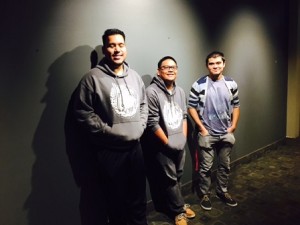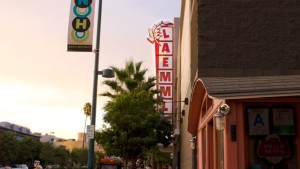Fil-Ams connect with ‘Ricky Lee Film Festival’ in North Hollywood

Among the FASA students attending the four day festival, from left Julio Portillo Jr., Joshua Rocha and Michael Sedillo. CECILE OCHOA
LOS ANGELES — Four films considered to be a classic representation of award-winning Filipino screenwriter, journalist and playwright Ricky Lee’s body of work, spanning more than 30 years, resonated well with second-generation Filipino Americans.
The four vintage films were showcased at the festival April 6 to 27 at the “Ricky Lee Film Festival” at the Lamelle Theater in North Hollywood: “Himala”; “Karnal”; “Anak” and “Dubai.”
Ricky Lee is one of the most renowned writers and screenwriters in the Philippines, a recipient of prestigious awards such as Palanca Memorial Awards, Life Achievement Awards for film from the Cultural Center of the Philippines, Urian, Gawad Plaridel, among others.
In an earlier local television interview, Sid Balatan, the Ricky Lee Film Festival director-general, said Lee’s works were selected because these depicted the social situations and cultural backdrops of Filipinos.
“The movies we selected span 30 to 40 years, from the Marcos era in the ‘70s and more recent central themes of overseas workers as in ‘Dubai’ and ‘Anak.’ These can answer some of the questions of second-generation Filipino Americans about the country their parents came from,” he said.
” I am strongly endorsing the four Filipino classic films in this festival as the messages resonates among Filipino immigrants and their children who made Southern California, particularly Los Angeles, their home, ” Balatan added.
The Filipino American Students’ Association (FASA) of California State University Northridge supported the festival that was sponsored by Justice for Filipino American Veterans, FilAm Arts and other groups in Los Angeles. FASA provides activities that promote closer unity among Filipino Americans and involves them in the propagation and maintenance of the Filipino cultural and historical heritage.
CSUN students expressed appreciation for the film festival. In an interview with INQUIRER.net, Joshua Rocha, 24, who is the cultural chair of FASA, said the movie “Anak” hit home hard: “When we were living in the Philippines my dad was away most of the time to work in the U.S.
I understand the struggles my dad had here as a foreign worker. He talked to me a lot–the separation, the loneliness of being away from his family, not being acculturated in this society.”
Rocha said he went through a rebellious stage even though he understood the sacrifices of his father. “For those of us who grew up in that kind of surroundings, it’s important that there’s no cultural gap with parents now. That’s the importance of this film festival,” he said.
Likewise, Ryan Francis Canete, 22, who was born in the U.S., said the movies “hit home as my dad was always away and he would later talk to my sister and me about the loneliness of being alone in a foreign land.”

Ryan Francis Canete, 22, a third-year student at CSUN, appreciates the cultural bridge of Lee’s films for both first and second generation Filipino Americans. CECILE OCHOA Ryan Francis Canete, 22, a third-year student at CSUN, appreciates the cultural bridge provided by Lee’s films for both first and second generation Filipino Americans. CECILE OCHOA
The term first-generation has been generally described as people who were born in one country and relocated to another at a young age. The term second-generation refers to children of first-generation immigrants.
Michael Sedillo, 24, who is the fundraising chair for FASA said he was glad to have watched the movies at the festival because he now understands how these issues relate in his life. “My mom worked in different countries as a nurse. She sent us care packages while we were in the Philippines like the ‘balikbayan’ boxes depicted in the movie ‘Anak.’”
The Balikbayan box (or bulk shipment of material goods) has become a cultural manifestation of the immigrant’s ties to their loved ones by sharing goods they enjoy in the adopted land. “She sent us money, but I never understood how difficult her life must have been here before we joined her,” Sedillo said.
The phenomenon of the Overseas Filipino Workers (OFWs) is aptly depicted in the film “Anak” and “Dubai.” An estimated 2.4 million OFWs have worked abroad at any time during the period April to September 2015.
Winston Emano, FilAm Arts executive director said there were other noted Filipino films simultaneously showcased in the Los Angeles Asian Film Festival and the Newport Film Festival that depicted the narratives of immigrants. “Better coordination needs to be done in the future to make these films accessible to more people,” Emano said.















